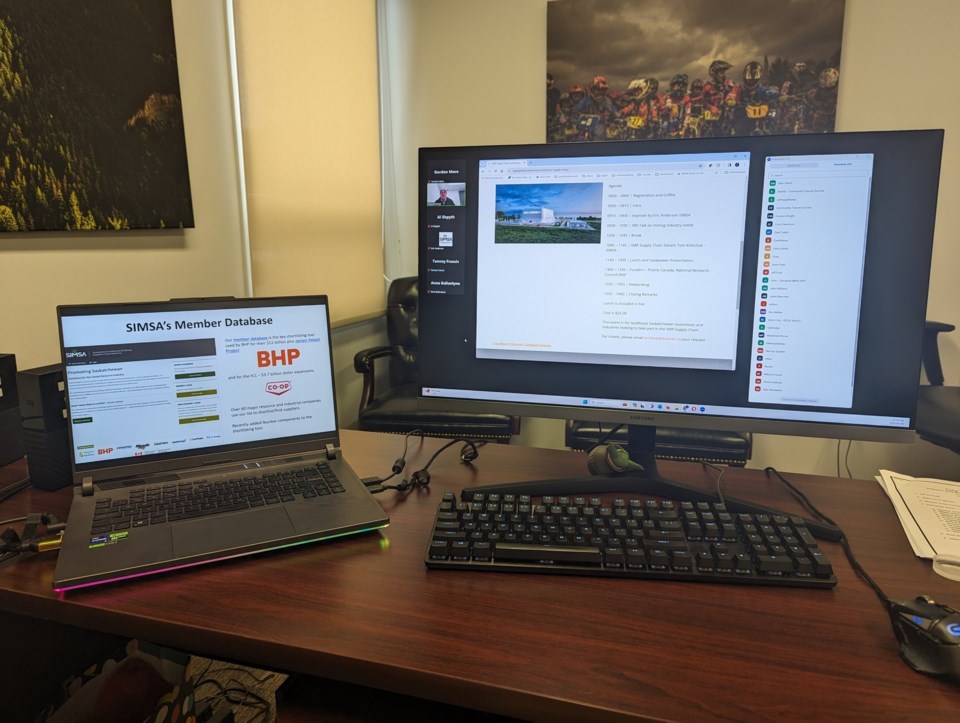ESTEVAN — The Southeast Techhub, alongside the Southeast College, hosted a day of education and discussion with SMR Supply Chain and Mining Innovation on Feb. 8. The event, which was to take place at the college's Estevan campus, shifted to an online format due to the weather.
Fortunately, most participants were able to join the educational gathering, said Techub executive director Gordon More. Around 40 people had a chance to learn from speakers – specialists of different profiles in small modular reactors [SMRs] and mining.
Opening the day was Eric Anderson of the Saskatchewan Industrial and Mining Suppliers Association (SIMSA), who talked about the current situation in energy generation, both in Saskatchewan and in the world, and nuclear as the opportunity for energy baseload generation in Saskatchewan.
The next presenter was Al Shype from the International Minerals Innovation Institute, who touched on mining innovation and potential future job growth.
"The draw for this conference/webinar was the SMR. But there is a real need for supply chain innovation when it comes to mining. Don't forget that the nuclear reactors' fuel is mining – uranium. So, there's a lot of opportunity here. And a number of the mining companies have been making overtures saying that we need more innovation in mining in Saskatchewan," More noted.
"So Al talked about that … And he asked the group, what solutions do you have in oil and gas that can be brought over to mining, and we had some interesting discussions."
Next up was Tom Kishchuk of SIMSA, who worked for Hitachi for years.
"The boilers that are at our power plants now are Hitachi boilers, so a nuclear reactor is just another way to boil water. Coal boils water, and nuclear reactors boil water. After the core part of a nuclear reactor, it's pretty much the same as what we already have here," More said.
"So, with [Kishchuk's] understanding and knowledge working for Hitachi, knowing the nuclear reactors or GE Hitachi, he was really breaking down, what kind of certification and documentation you, your employees and your company would need to have to be able to be making parts for the supply chain.
"He then broke down the different parts of the supply chain and talked about what parts would be made right by GE Hitachi, like the core parts; what parts would be part of the global supply chain; and what parts would be part of the local supply chain. So it was really technical, and it was really good."
Kishchuk also touched on international SMR projects currently in the works in Europe and elsewhere, which can be of interest to local businesses as well moving forward.
The next presenters were Anne T. Ballantyne, the manager of program development & co-ordination, strategic initiatives and ecosystems with Prairies Economic Development Canada, and then Tammy Francis, client engagement advisor, industrial research assistance program with the National Research Council (NRC). Both touched on funding for businesses to retool and retrain to become a part of the SMR supply chain.
"Both Prairies Canada and NRC have pathfinding to different government funding as well as government funding for that," More noted.
SaskPower project manager Darcy Holderness did an overall review of the Saskatchewan SMR project and touched on SaskPower's role as an auditor of CSA certification.
"He did a backwards timeline saying that, if you're going to supply parts for the two SMRs here, they start building it around 2031, you actually need to start the process now, because if you wait to 2030, all these other people that have already started the process will be way ahead of you," More recollected.
More also addressed participants, noting that as the executive director of the SE Techhub, his responsibilities include helping companies reach out and get private or venture capital or angel investments.
More said their marketing efforts attracted southeast Saskatchewan business owners who are looking to diversify their manufacturing and customer base through the SMR and mining supply chain.
"I saw people who deal with the electric side of the oil and gas industry there, as well as pressure vessels manufacturing, pipeline manufacturing and control valve companies there … It was the right group of people," More said.
"This conference was to help build up the supply chain because the first GE Hitachi BWRx-300 [SMR] is being built in Pickering, Ontario, and they are discovering that the Ontario supply chain is lacking. So GE Hitachi really is reaching out to Saskatchewan, in particular, because there's such a good push from our provincial government and from SaskPower to help build up the supply chain because Ontario has fallen behind," More said.
"And that is the right thing to do because if we get these two SMRs, that's great, we get 3,000 construction jobs, something like that, for a decade. Most, if not all the workers that are working at the coal-powered power plants here, their jobs will translate over there. Fantastic. But then what happens? Do we then return back to what Estevan is right now? I say no.
"When you have the largest construction project in the history of Saskatchewan in the backyard, it's about building the spin-off so that when you come back out the other side, you have more jobs, more industry, more people working and a larger population here because of that," More said, sharing his vision.
"So one way to do that is to say look, they're building the second and the third SMRs in the world in our backyard, and the skill set needed to build the supply chain parts is 80 per cent the same as oil and gas manufacturing or mining. To me, it's a no-brainer.
"The challenge is an opportunity," More summarized.
He is looking into organizing another similar event in the late fall or early winter.
The presentations from the event can be found at the Southeast TechHub's website under past events.





